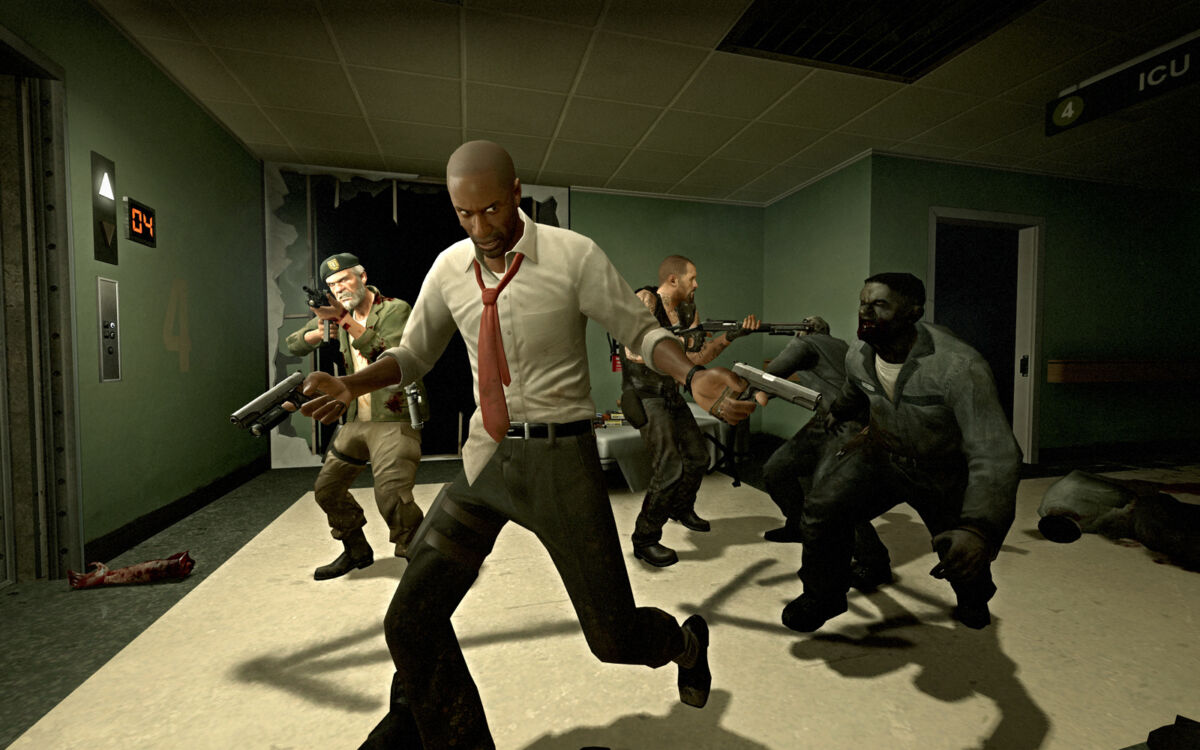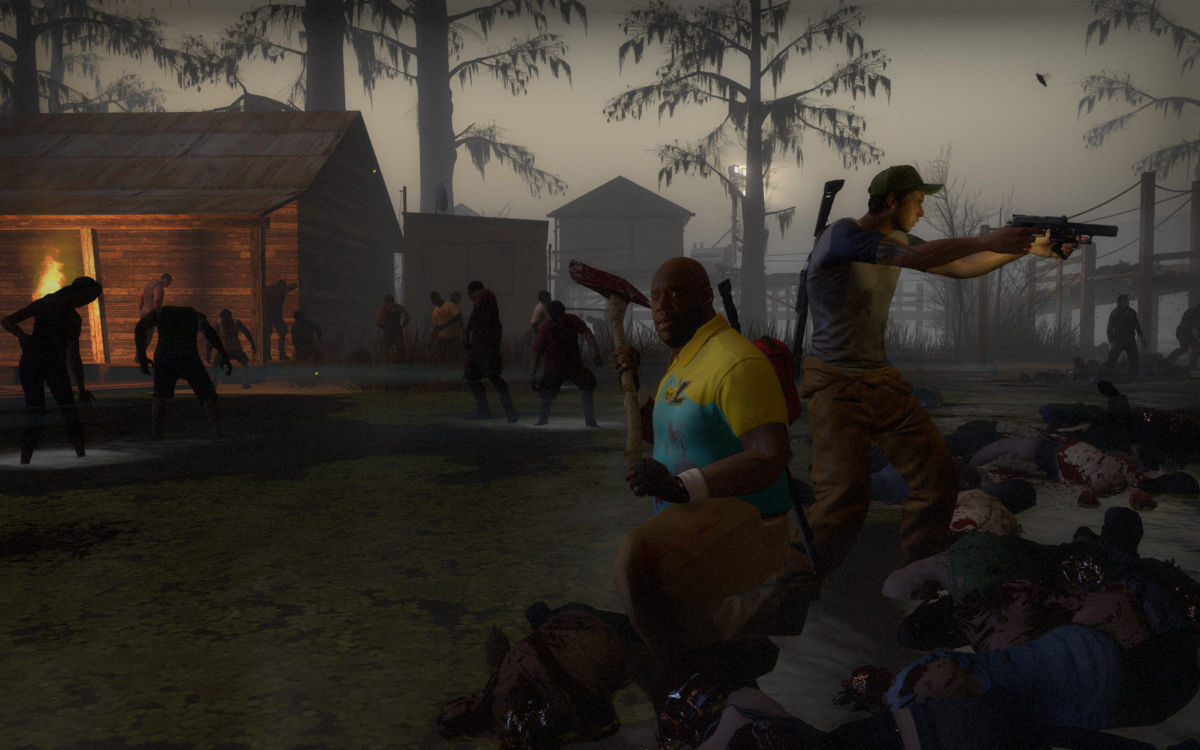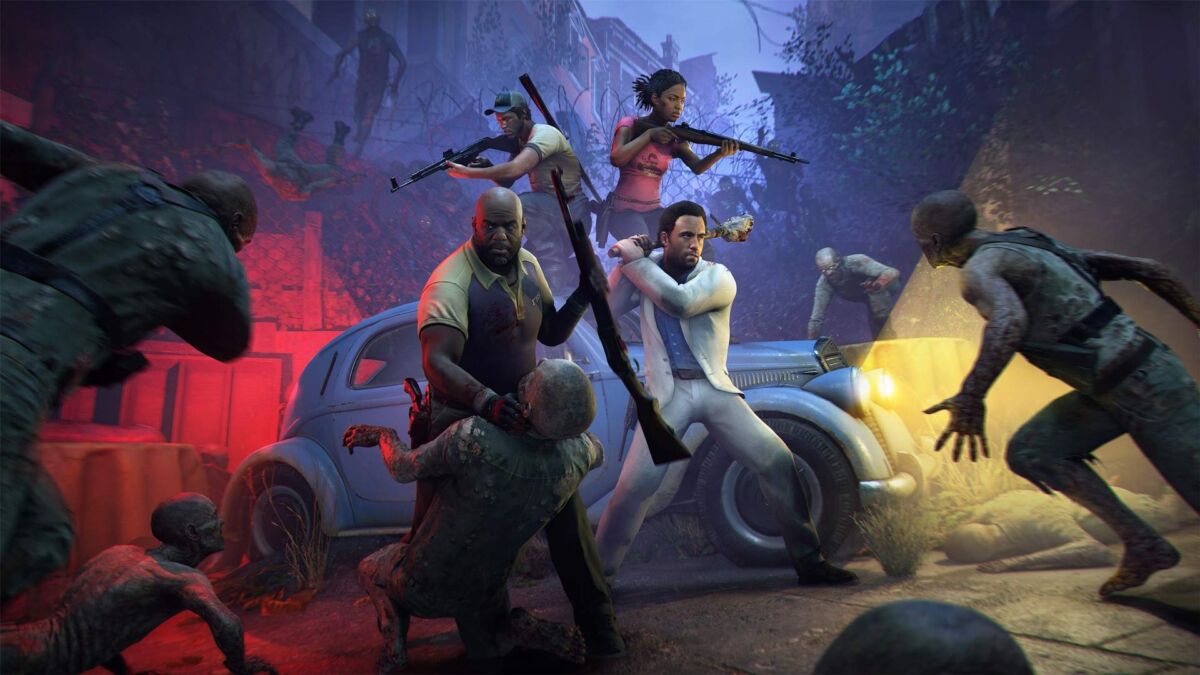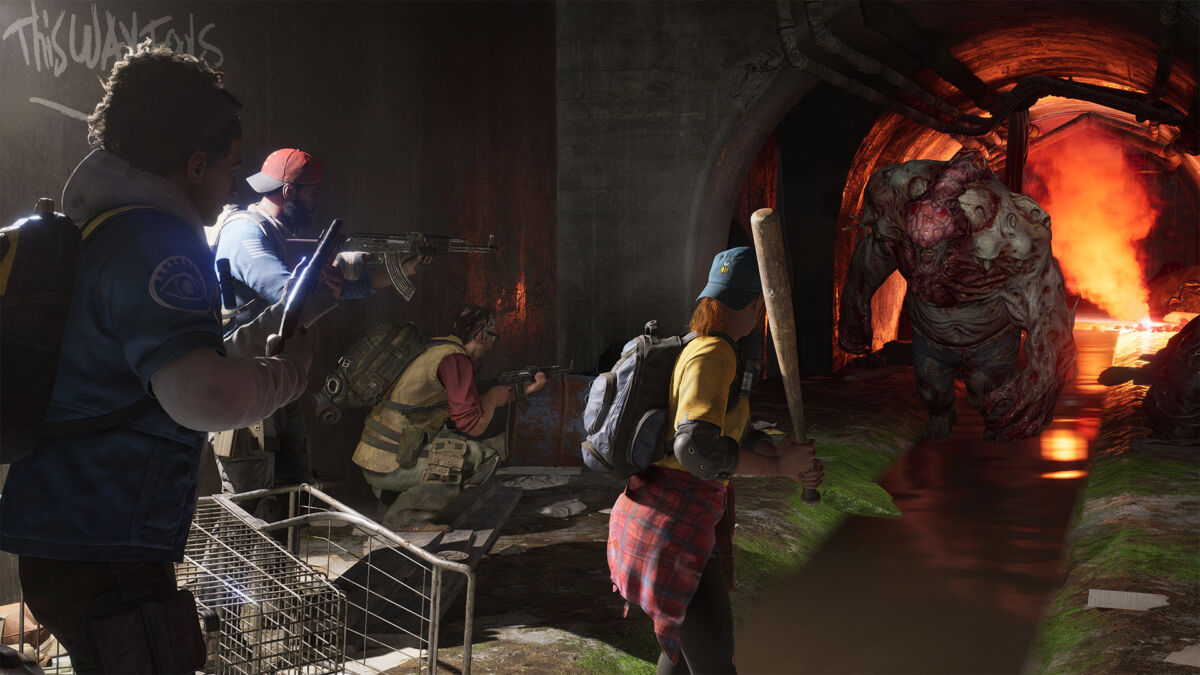If one game series seems to have influenced co-op gaming more than any other, it’s Left 4 Dead. The 4 vs all zombie horde shooter is considered by many gamers of a certain age to be their first memorable online co-op experience, and the formula, or small aspects of it, has gone on to inspire the likes of World War Z, Zombie Army, Deep Rock Galactic, Vermintide, Payday and others.
Despite its relatively short lifespan, with only two games released in the space of 12 months, Left 4 Dead’s legacy is still being felt to this day. Literally, this very day even. As this is being published, spiritual successor Back 4 Blood is launching on PC, PS4, PS5, Xbox One, and Xbox Series X | S, along with a release through Xbox Game Pass. With that in mind, we’re taking a trip down memory lane to celebrate the history of Left 4 Dead.
Patient Zero (Left 4 Dead)

Developed by Turtle Rock Studios, Left 4 Dead entered into development around mid-2005 before being revealed by the end of 2006. Previously, Turtle Rock had been known as the developers behind Counter-Strike: Condition Zero, so there was a keen sense that Left 4 Dead had the potential to do for co-op games what CS did for multiplayer gaming. Valve’s Gabe Newell even said as much in a press release regarding the announcement.
The premise of Left 4 Dead couldn’t be simpler, with you controlling four survivors (Bill, Zoey, Louis and Francis) as they try to survive against hordes of infected, running, gunning and sometimes even both with the hope of reaching that chapter’s safe room. Each campaign was composed of numerous chapters, with the last one typically being a massive finale set piece that requires players to work together in order to win.
Of course, the survivors weren’t just contended by basic jobber infected who ran at the player, looking to take a few swings. Littered amongst the hordes were special infected like The Witch, The Tank, The Hunter, The Smoker and The Boomer. All of these special infected had their own unique abilities that could easily put the survivors in peril. Hunters and Smokers in particular could immobilise survivors, leaving them trapped for another survivor to rescue them.
Left 4 Dead ran on an overhauled version of Valve’s Source Engine, which included a lot of key updates to allow more elements and enemies to appear on screen at any one time, but the biggest change came in the form of the AI Director, which altered the experience of every campaign every time you played. By changing enemy and item spawns, the Director ensured that players were always kept on their toes.
During development, Left 4 Dead went through various changes and iterations with features that ultimately never made the full release. According to Jaime Sue, a member of the L4D dev team, during the game’s internal commentary, there was an enemy type called The Screamer, which wouldn’t attack players but attract the hordes, though the foe was dropped and the horde luring ability was tied to the Boomer’s vomit.
Upon launch in November 2008, Left 4 Dead proved to be a landmark moment in co-op gaming for PC and Xbox 360 players. The game achieved a fantastic 89 on Metacritic, with most agreeing that once you had a full team of players to enjoy the game with, there were few co-op experiences as satisfying. The sales were nothing to sneeze at either, as L4D achieved 3 million copies sold worldwide within less than a year of release.
Left 4 Dead 1 also received a healthy dose of post-launch DLC and updates, including a new Survival Mode, an additional campaign in the form of Crash Course, and retained a healthy following for a long time after launch. Even though there weren’t a huge amount of campaigns, Left 4 Dead was still endlessly replayable.
Unfortunately, there was trouble brewing.
Lockdown (Turtle Rock’s Split From Valve)

Earlier on in 2008, Valve purchased Turtle Rock Studios, with Gabe Newell remarking at the time that it was an easy decision to make: “We have been seeing very strong growth with Steam and Source, our content distribution and development platforms, up over 150 percent over the last 12 months. Given our expectations for Left 4 Dead and our long-standing relationships with members of the Turtle Rock team, this was an easy decision.”
Upon purchasing the studio, Turtle Rock was rebranded Valve South, and continued to work on Left 4 Dead, but after the game’s release, Valve asked the southern branch’s employees if they’d like to work within Valve proper at their Seattle studio. Many of the staff compiled, and Valve followed that up with the decision to close down Valve South.
The decision to split again was said to be amicable, as both parties faced struggles when it came to adjusting to the new normal. Speaking at a press event a few years later, Turtle Rock co-founder Phil Robb talked about the culture of Turtle Rock changed once they became Valve South, and how that wasn’t necessarily for the better:
“Co-developing and working on one product, when both teams, two super tight-knit teams, are 800 miles apart, it’s a nightmare. There was a lot of tripping over each other. At the end of the day, after we shipped it, no-one was really happy with how it worked. So we sat down with Gabe [Newell] and talked about it, and it just made the most sense that, y’know, why don’t we go back to what we knew worked, which is us going independent again, and certainly they’d have work for us.Whenever we were working with Valve, it was kind of crazy. They take their time, y’know? Valve time’s a well-known thing, but for us it was like we want to get this shit done.”
Second Wave (Left 4 Dead 2)

Fully aware of the success on their hands with the original Left 4 Dead, work quickly began on the sequel, which was revealed during Microsoft’s press conference at E3 2009. The sequel followed a new cast of characters (Nick, Coach, Eliis and Rochelle), as they also tried to survive against the insurmountable odds facing them at every turn. If it sounds similar to the original game, it is.
Not long after L2D was revealed, a boycott emerged that received over 30,000 members by the end of June 2009. Forming a Steam community group known as “L4D2 Boycott (NO-L4D2)”, the group believed Valve were abandoning Left 4 Dead 1 in favour of a sequel that could have been released as DLC, and that a new game would fracture the community of both Left 4 Dead and its sequel.
In fairness to Left 4 Dead 2, the sequel includes a number of new features that build on the foundation of the original game, making for a more enticing package as a result. Perhaps the most immediately noticeable change was the addition of melee weapons, allowing players to smack the living crap out of the infected with baseball bats, guitars, hammers and more. For close-ranged horde clearing, melee weapons were incredibly satisfying.
Left 4 Dead 2 also included 5 brand new campaigns focused on the four new main characters, along with another 3 special infected to contend with. The infected, known as The Charger, The Spitter and The Jockey, felt like they were aimed at Left 4 Dead’s versus mode, which pitted a team of 4 survivors against 4 infected players, allowing the Infected to better work together. Using a Jockey to steer a survivor into a Spitter’s acid, or into the range of other infected, allowed teams to become twice as deadly.

The A.I. Director was also massively improved, as it actively changed the level’s layout on a per playthrough basis. While most of the checkpoints and level beats remained the same, certain fence positions or doors would change, altering your path in small but noticeable ways. The Director also tried to entice the players to take more risks, offering more rewards like better guns or upgraded ammo on the more dangerous path.
When Left 4 Dead 2 launched on Xbox 360 and PC in November 2009, it quickly became regarded as one of the best games ever made, again earning an 89 on Metacritic. If it worked in Left 4 Dead 1, it worked for the sequel, but critics recognised that L4D2 featured enough in the way of improvements to make it the preferable option compared to its predecessor. Sales-wise, Left 4 Dead 2 was a massive improvement, with EA (the game’s retail distributor) claiming it had sold 2.9 million copies by February 2010.
Of course, the real victory came before launch, when the boycott group folded, and it was revealed by Gabe Newell that data suggested that “boycotters” were more likely to reserve the sequel than non-boycotting owners of Left 4 Dead 1. Guess there really is no such thing as bad press.
Much like the first game, Valve weren’t finished after the game had launched though, with multiple DLC and updates released afterwards that extended the game’s lifespan even further. The most notable addition was the two campaign stories of The Passing and The Sacrifice. Together, both DLCs told two sides of a story that saw the Left 4 Dead 1 protagonists interact with those from the second game.
The first piece, The Passing, launched in April 2010, while The Sacrifice launched in October 2010 as arguably the more significant offering. While The Passing included a new campaign, The Sacrifice boasted a new campaign plus the return of the first game’s iconic No Mercy campaign, further solidifying the idea that Left 4 Dead 2 was designed to be the ultimate version of this co-op shooter.
Decay & Doppelgangers (Cold Stream, The Last Stand & Legacy)

That first year of Left 4 Dead 2 was the most active for the community, particularly for console players who weren’t privy to the likes of modded, community created campaigns. Valve seemed to be aware of the feeling that console players were potentially being left out, and a community-created campaign in the form of Cold Stream was released alongside the other Left 4 Dead 1 maps as DLC.
While new content and the return of old content is certainly nothing to grumble at, the issue was that the DLC only launched in the middle of 2012, a year and a half after the last official release. By that point, the game retained a hardcore following that enjoyed what Left 4 Dead had to offer, but the general playbase just wasn’t what it was. Also, the fact that new content came from the community and not Valve themselves might have sent the message that the actual developers were pretty much done.
It took another 8 years for Left 4 Dead 2 to receive another official release, but again, this was a community curated collection that just happened to be released by Valve. Named The Last Stand and based on a survival map in Left 4 Dead 1, the content package includes dozens of new survival maps, a new mini-campaign, new weapons, some additional tweaks and more. For the diehard, it was a nice inclusion, but it’s hardly enough to resurrect a series.

In the intervening years between Cold Stream and The Last Stand, Left 4 Dead’s legacy was felt across the gaming industry. Arguably responsible for the gaming industry’s bigger push towards co-op gaming as a core genre staple, many developers have looked to the fast paced formula that L4D championed as a source of inspiration. Again, what’s World War Z if not third-person Left 4 Dead? It’s still great fun, but Left 4 Dead paved the way.
Overkill’s Payday series also felt somewhat similar to the Left 4 Dead series, applying the four vs all concept to bank robbers vs police instead of survivors vs zombies. Still, those never ending police waves start looking like Left 4 Dead really quickly. Payday even featured a collaboration with Valve for the No Mercy campaign as free DLC for the first Payday game, with the DLC launching in July 2012.
The characters from Left 4 Dead have also appeared in other properties, some in more surprising locations than others. In 2013, a collaboration between Valve and Capcom led to a crossover between Resident Evil 6 on PC and Left 4 Dead 2. All four playable protagonists from L4D 2 appeared in the Mercenaries mode, while three RE6 skins were added to the Steam Workshop to change the looks of the Special Infected. Left 4 Dead’s characters were also featured in Zombie Army Trilogy and Zombie Army 4, and Bill from L4D 1 was even a survivor in Dead by Daylight, which is still baffling.
Resurgence (Back 4 Blood)

Throughout the years of Left 4 Dead’s legacy being assimilated into various games, Turtle Rock Studios have remained relatively quiet. In 2015, they debuted their new game, Evolve, a 4v1 sci-fi hunting game that saw a team of players take on one powerful monster, but despite various attempts, Evolve just couldn’t get off the ground in the same way that Left 4 Dead did. After a failed partnership with Perfect World Entertainment, the team decided to work with Warner Bros. to return to what worked: zombie horde shooting.
The not-so-subtly titled Back 4 Blood is a spiritual successor to Left 4 Dead, with a team of four unique characters working together to fight back against hordes of infected and Special infected in fast-paced levels that require teamwork, communication and a little bit of luck. While replaying the greatest hits under a new name and calling it a day might seem like it’ll only yield short-term benefits, Back 4 Blood aims to truly reiterate the formula.
The gameplay remains the same, or at least similar enough for players to be immediately familiar, but there’s an actual emphasis on skills and abilities, something that Left 4 Dead didn’t have. Each character has their own skills that can make them useful in different scenarios, and when starting levels, you can draw from your curated deck of cards to equip new skills and abilities that’ll make you deadlier, heal more, offer more ammo to other players and other various buffs. Of course, there’s also a Director who will add their own buffs to the hordes that’ll make your life a living hell.
As we’ve written this ahead of the game’s proper launch, it’s hard to tell how much of a success Turtle Rock’s return to zombie murdering will be, but the beta certainly felt promising, and from what reviews have dropped at the time of writing, it seems like Back 4 Blood is an incredibly enjoyable thrill ride, so long as you’ve got the friends to play it with. That said, with Back 4 Blood coming straight into Game Pass at launch, there’s every possibility that it manages to capture the success that Left 4 Dead received. It’s a tall order, but if anyone can do it, it’s Turtle Rock.
READ MORE: How Dead Space 2’s Most Horrifying Level Relies on the Original’s Legacy
Some of the coverage you find on Cultured Vultures contains affiliate links, which provide us with small commissions based on purchases made from visiting our site.

